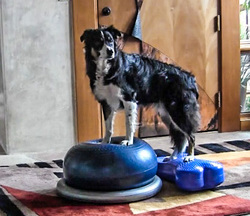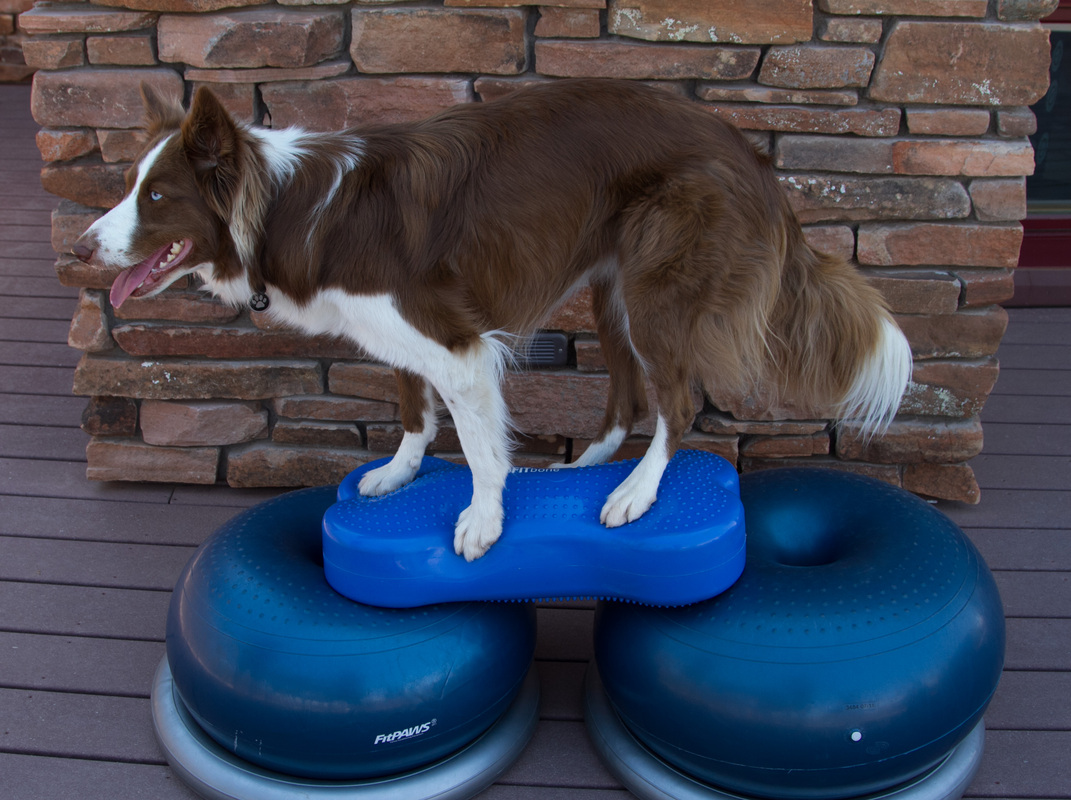
Over the past 14 years that I have been training performance dogs (Pulik and Border Collies). I have not only had injuries in all my performance dogs but everyone I know that has a performance dog or a very active companion dog has had some type of injury.
It is not surprising that we are beginning to hear more about these injuries in our sport dogs since we are asking more and more of them not only at very early ages but throughout their lives. AND, I have to wonder if our lack of knowledge about the importance of building core strength, body awareness and fitness in our dogs is contributing to their injuries.
We all have seen or been guilty of taking a dog right out of their crate for either agility exercises in a class or seminar and just before running our dog at a show. The warm-up might consist of a few jumps over a practice jump but in classes and seminars that does not even usually happen.
In the past there were people who wrote that dogs did not need to warm up like human athletes do since dogs were meant to just spring into action, running, jumping, chasing for food or whatever they do in the wild.
Those of us that have had injured dogs and experienced the long time it takes for rehabilitation know the importance of prevention. In some instances the dog never seems to perform at pre-injury level or in other instances, the injury re-occurs.
My background in medicine, education and sports has led me to research and read extensively about how to condition our dogs to not only help them be better in their sport, prevent injuries but also to help them be able to be physically and mentally active as they age. Thus, the “Top 5 Reasons that all Dogs Should Use Balance Discs”.
Reason #1: To help properly condition our dogs and prevent injuries
Christine Zink and Janet Van Dyke recently published an excellent book, Canine Sports Medicine and Rehabilitation (2013) that presents their work, and an impressive collection of work by veterinary health care specialists such as surgeons, nutritionists, physical therapists and rehabilitation specialists. Each of these specialists shares their experiences, expertise and research in veterinary sports medicine and rehab. While this book was perhaps originally published for those that care for the canine athlete, it is so well written that those who work with performance dogs or have dogs in rehab will find this book very interesting and helpful.
Much of what is known today about canine sports medicine and rehab comes from the application of scientifically based principles and rehabilitation that have evolved from experiences with human athletes. Much of the research about the canine athlete comes from data collected on two athletic extremes: the sled dogs and sprinting dogs like the Greyhounds.
The chapter that I found to be so informative was the one by Dr. Zink on “ Conditioning and Retraining the Canine Athlete.” She writes, “ a balanced exercise program includes strength (anaerobic) training that targets the forelimbs, pelvic limbs and/or CORE BODY MUSCLES, endurance (aerobic) training, PROPRIOCEPTION AND BALANCE, preparation and recovery (stretching and flexibility) and skill training. The program should balance duration, frequency, and intensity of training while avoiding overtraining. “
In reading this chapter I was not surprised that Kaffee was injured (iliopsosas strain) while chasing a ball. While I believed he was very fit, his fitness certainly did not involve core strength and proprioception work. And, being very tight in his back, he has never been able to easily or willingly stretch out his rear legs. Myst, on the other hand, has been conditioned and trained pretty much following Dr. Zink’s guidelines for a balanced exercise program. When she was a puppy she was introduced to balance discs and today has amazing balance, core strength, flexibility and procrioception.
Reason #2 – Balance disc work helps to keep our aging dogs young
We have long known the benefits of exercise for humans and its effects on aging. We now know that physical activity also has a positive effect for our dogs, helping to improve cognitive function and reducing the risks of cognitive impairment
Scientific publications have published reports of cognitive dysfunction syndrome (CDS) in senior dogs. In some dogs symptoms can be seen as early as 7 years of age. As a result of these studies papers have been written that have examined the positive impact of dietary supplementation, physical activity, environmental and cognitive enrichment on aging and CDS.
Cognitive enrichment involves helping to keep the dog’s mind sharp by teaching it new things. There are many ways we can help our dogs stay mentally sharp and help them use their minds. With Kaffee I have mentioned his new work and progress with all the different balance discs. He has to focus on his balance, new body awareness and how to maneuver each of his limbs separately, yet with coordination. This was a challenge for Kaffee when he first started working with the balance discs, but now he is doing so well with finding where to put his front and rear feet even on the tiny paw pods.
Teaching a dog how to use balance discs, and shaping behaviors on the discs involves the use of cognitive functions to use limbs independently, to bend, flex and isolate and stretch parts of their bodies all the while building their core strength, body awareness and proprioception,
As with any exercise program it is important to have dogs warm up and cool down to prepare the body for work. The video, “Two Cool Border Collies Go To the Gym” shows Kaffee and Myst in warm-up, body awareness work on FitPaws canine discs, and shaped tricks used for cool down.
Reason #3: Balance disc work helps to strengthen and condition dogs without overtraining thus enhancing their skills in dog sports such as agility, flyball, herding and obedience.
It is very easy to over train our dogs in the sport we enjoy most. Techniques used by pro-athletes to not only improve their performance but also help prevent injuries involve the use of cross training. Using just one set of muscles repeatedly can increase the risk of repetitive injury. The harder the body is trained for just one activity, the more stress is put on all the bones, muscles, and joints involved in that activity leading to a greater risk for injury. Athletes now know the benefits of cross training which may involve anything outside the athlete’s primary sport; it means using different activities to ensure total fitness.
The use of balance discs help to provide cross training for our dogs. Canine fitness discs help to stretch and strengthen muscles and joints that may not be used while being worked and trained. Balance discs also provide an excellent way to warm up our dogs for these activities by helping them to stretch and hold these stretches in a fun way, while being focused on their human team partner.
REASON 4: Helps to calm your dog with the mental stimulation.
Having very athletic and high energy dogs, I have always felt committed to providing them with exercise at least once a day. Even if it is raining or snowing, we go out for some form of exercise, usually a hike. However, more recently I have found that when I take my two Border Collies back to their canine gym and do work with the balance discs, that after about 20 minutes of interacting with and asking them to think about how to use their bodies on the discs they are ready to relax and rest quietly.
Reflecting back, I can also remember so many times that just a few minutes of mentally working my dogs, relaxes them even more than a one hour hike.
I have not been able to find any research that supports this however, I suspect that I am not alone in experiencing of the calming effects of mental stimulation for my dogs. The mental stimulation with the balance discs comes with their challenging work to hold their balance and especially with the excellent and fun ways to help them discover their 4 limbs and how each relates to the other or how to maneuver each separately. The paw pods are my favorite for very stimulating work and excellent for proprioception.
Reason #5: Dogs LOVE this interaction with their owners since it is FUN, HAPPY, AND HIGHLY REWARDED and it helps build your dogs FOCUS ON YOU.
The work with the balance discs is done in our canine gym (a room in the house just for their balance disc work) 4-5 days a week. Both dogs love their late afternoon time working on their balance discs and learning new tricks. This fun time together not only provides cognitive enrichment but also a very stimulating environment where both dogs get to interact and play with me in a positive, fun way. During these times, my older dog Kaffee has my total attention and is the most important thing in my life – just like when he was a puppy.
The time we spend with our dogs showing them how to use their bodies on the balance discs is a fun, happy and positive time for us to spend with our dogs. We have no expectations of a behavior and the time spent is one of joy, happiness and sharing fun with our best furry friends.

 RSS Feed
RSS Feed